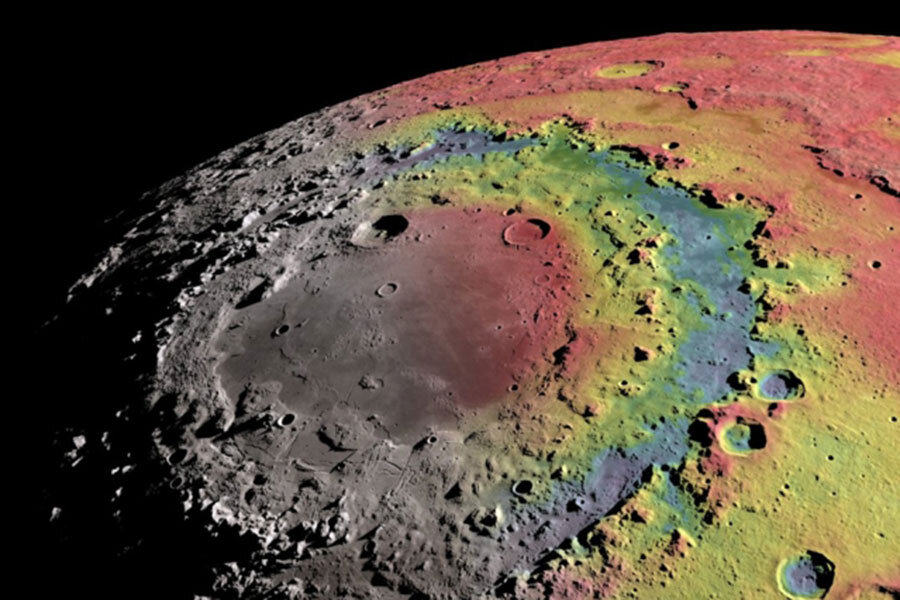How did the moon get its bull's-eye crater?
Loading...
One of the most striking features on the moon is Orientale Basin, a 580-mile-wide bull's-eye crater surrounded by three concentric rings – and scientists now think they know exactly how it formed.
In a joint pair of articles published in the current issue of Science, researchers explain how they used data from NASA's Gravity Recovery and Interior Laboratory (GRAIL) spacecraft to peer beneath the moon's surface and piece together the giant crater's story.
"Big impacts like the one that formed Orientale were the most important drivers of change on planetary crusts in the early solar system," said Brandon Johnson, a lead author of one of the papers and a co-author of the other. "Thanks to the tremendous data supplied by GRAIL, we have a much better idea of how these basins form, and we can apply that knowledge to big basins on other planets and moons."
Multi-ring craters exist all over the solar system, and most date from the first half-billion or so years of the solar system's history, during the period known as heavy bombardment.
"The Earth and the moon are in the same part of the solar system, so they were being bombarded by the same population of impactors, so Earth once had impacts that large,” Maria Zuber, a professor of geophysics at MIT and lead author of one of the studies, tells The Christian Science Monitor.
Earth's multi-ring craters have long since been smoothed over by geological processes like plate tectonics and erosion, but on the moon's airless, still surface, Orientale has remained largely undisturbed for 3.8 billion years. It is one of the youngest of these massive crater systems, and the best-preserved one in the solar system.
Seizing the opportunity to study a pristine multi-ring crater, NASA launched GRAIL in 2012 to fly over the moon at a height of just 2 to 4 miles, collecting unprecedented data and taking very high-resolution photos, Professor Johnson tells the Monitor. “That's why Orientale was the target of GRAIL's extended mission. The spacecraft flew really low over Orientale to get the best gravity data.”
GRAIL's gravity measurements allowed scientists to "see" below the surface and reveal the moon's hidden structures.
“We orbited the moon at an average altitude of six kilometers, which is lower than a commercial jet flies, and because we were able to orbit so low we could map the basin at a very high spatial resolution,” Dr. Zuber explains. “We were able to study aspects of the interior at spatial scales similar to the structures that we see on the surface.”
These high-resolution photos allowed her research team to map the basin, its rings, the extent of debris blasted away by the impact, and, most importantly, calculate the size and location of the "transient crater."
The transient crater is formed during the initial impact. Johnson compared this process to the momentary bowl-shape formed when you drop a rock into a pool of water. In a small impact, the transient crater can become permanent, but in large collisions the crater, the massive structure typically collapses in on itself.
Many scientists previously thought that one of the three rings represented the outline of the transient crater, but Zuber used the gravity data to show that it existed between the two inner rings of the bull's-eye.
The map she and her colleagues created then informed a computer model used in Johnson's study to simulate how Orientale's crater was formed.
The scientists concluded that Orientale Basin was formed by a 40-mile-wide object traveling 9 miles per second. The transient crater flung huge volumes of material outward, and the warm and weak material from the moon's mantle – the layer beneath the moon’s crust – moved upward. Some of the dramatic cliffs created by the impact were preserved as the outer two rings.
“The inner ring formed later,” Johnson explains. “After the collapse of this transient crater, it actually forms a central uplift ... and that uplift itself then collapses and it pushes the material out, forming this inner ring.”
The whole process occurred very quickly, with cliffs several miles high and the inner crater all forming within minutes of the initial impact.
What made the Orientale Basin a good subject for this study was its pristine condition and the absence of geological forces that exist on planets like Earth, but what will make the data collected useful going forward is what similar impact points on other planets say about the evolutionary history of the solar system, say the scientists.
"One of the things that we found is that where the rings were located is sensitive to what the temperature of the moon was at the time of this impact," Johnson tells the Monitor. "By comparing other basins on the moon to Orientale, we might be able to get a sense of how the thermal structure of the moon changed ... and we might be able to do a similar thing on other planets."
Mars looks like a likely candidate, as it still has some of its multi-ring craters.
Earth's largest craters have been almost entirely eroded, or destroyed by plate tectonics, but the data still offers clues into what our planet looked like in its early history.
“At the time that these impacts formed, 4 billion years ago, this was the time in Earth's history when the first single-celled organisms were forming," MIT's Zuber explains. "Goodness knows how many times life might have developed and gotten wiped out and had to emerge again."
She adds, "It really gives us a window into the extreme environmental conditions of the early Earth."






